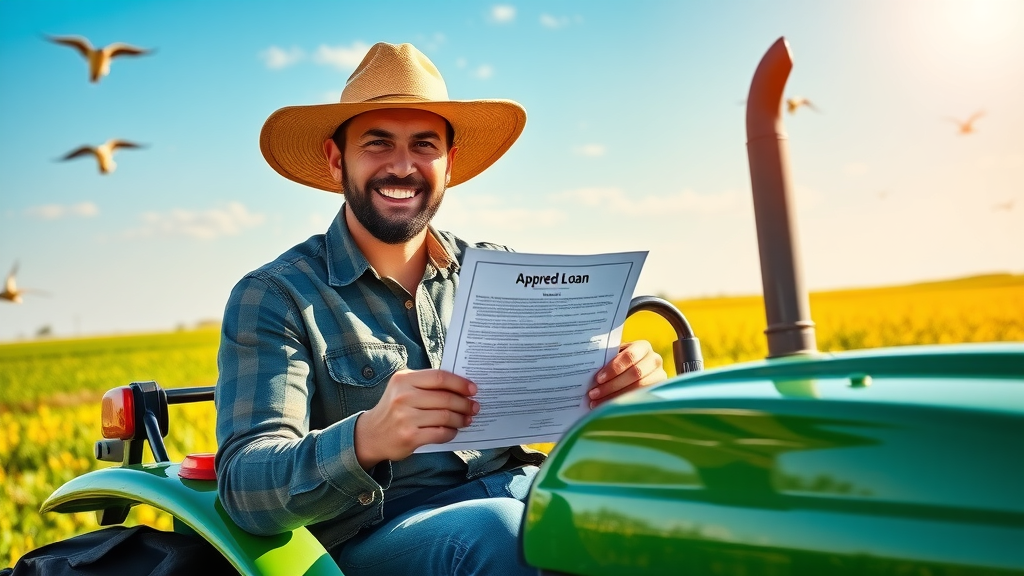Did you know that over 70% of new farm equipment purchases are now financed, not paid in cash? If you’re among the many farmers facing high upfront costs, complex paperwork, or strict lender requirements, you’re not alone—and the good news is, there’s a proven way to make tractor equipment financing work for you. In this detailed guide, we’ll help you break down the process, compare your financing options, and understand how you can equip your farm for growth without breaking the bank. Whether you’re looking to upgrade your old tractor or need the latest ag equipment with smart tech features, this article will give you the tools to act with confidence.
Tractor Equipment Financing: A Growing Need in Modern Agriculture
As farms become larger and more high-tech, tractor equipment financing has never been more crucial. Farmers, co-ops, and ag businesses face mounting pressure to modernize their machinery and stay competitive. Most simply can’t afford the full upfront costs of a new tractor or combine. This shift means that equipment loans and tailored equipment financing solutions are now essential for every successful farming operation. Lenders, manufacturers, and local dealers have responded by developing more flexible terms, including fixed rate and variable rate offers, seasonal payment schedules, and faster approvals—ensuring that you can access equipment exactly when you need it. Whether purchasing new or used farm equipment, the right financing option can be a game-changer, letting you expand capacity while keeping your cash flow healthy.
The trend is clear: instead of hefty initial investments, producers now strategically leverage tractor equipment loans, farm credit programs, and competitive offers from online and community lenders. When paired with smart business planning, these options empower farms of all sizes to upgrade agricultural equipment, maintain reliable machinery, and boost overall efficiency. In the next sections, we’ll dig deep into why this approach works and how you can take advantage.

Startling Trends: Why Farmers Rely on Tractor Equipment Financing Now
Modern farmers face rising machinery costs, unpredictable markets, and a fast pace of technological change. This has led to a surge in tractor equipment financing as a smart solution. Rather than draining cash reserves, farmers are using loans and leases to spread costs over several years, preserving capital for seed, fertilizer, and expansions. With more than 70% of new farm equipment sold via financing, this is no longer a fallback—it’s become the norm. The result? Increased adoption of smart tractors, GPS-guided implements, and cutting-edge ag equipment that would be otherwise unattainable.
"Over 70% of new farm equipment purchases are financed, not paid in cash—evidence of the sector’s growing reliance on accessible tractor equipment financing solutions."
Leasing and loan options now offer flexible payment plans, often with tax advantages and lower financial risk. As equipment becomes more high-tech, lifetime support and maintenance programs are also often bundled with financing, giving producers a safety net against costly breakdowns. In short, tractor equipment financing puts advanced ag equipment within reach, helping farmers optimize productivity and stay resilient in a challenging industry.
What You'll Learn About Tractor Equipment Financing
Key features of tractor equipment financing
How tractor equipment financing compares to other farm equipment options
Tips for qualifying for equipment loans and leases
Understanding rates, terms, and documentation
How ag equipment and agricultural equipment finance plays a role in your operation
What is Tractor Equipment Financing?
Tractor equipment financing is a structured way for farmers to obtain the tractors and attachments they need through tailored financial products, rather than paying the entire purchase price upfront. This approach includes traditional equipment loans, leases, and specialized ag equipment financing programs offered by banks, credit unions, farm credit organizations, and even direct from equipment dealers. Financing programs generally feature competitive rates, flexible terms, and quick application processes, making them accessible for operations large and small. Whether you need a single compact tractor or a fleet of cutting-edge machines, understanding this financing path can help secure your farm’s future growth while preserving your operating capital for other needs.

Defining Tractor Equipment Financing and Its Benefits
Tractor equipment financing allows you to break down the cost of high-value farm machinery into manageable monthly payments, often with lower upfront costs and flexible repayment periods. Benefits include quick access to the best ag equipment on the market, improved cash flow, and the ability to stay current with technology through scheduled upgrades. Financing options can also cover attachments, precision agriculture hardware, and even extended service plans. The biggest advantage is reduced financial risk—farms can scale their equipment as needed, matching payments to seasonal cash flow, rather than being locked into a single purchase or draining savings.
Additionally, equipment financing improves budget predictability because payments are fixed or, with some variable rate options, remain closely tied to market conditions. By leveraging programs offered by farm credit systems, banks, or online lenders, you can also negotiate for competitive rates and terms that suit your operation. This flexibility ensures you always have the right machinery to match your growth or crop plans, turning what once was a financial burden into a strategic advantage.
Farm Equipment vs. Ag Equipment Financing: Key Distinctions
While often used interchangeably, there are key differences between farm equipment financing and ag equipment financing. Farm equipment financing typically refers specifically to machinery directly used in planting, harvesting, and fieldwork—like tractors, plows, and combines—while ag equipment financing can also include broader categories such as irrigation systems, storage units, or livestock handling facilities. Understanding eligibility criteria, repayment schedules, and the range of assets covered by different financing programs is crucial for maximizing your access to funds and ensuring you’re using the right program for your farm’s needs.
For example, tractor equipment financing often carries the most competitive rates when restricted to tractors and core field implements, while ag equipment financing may have broader but slightly higher rates to accommodate more diverse equipment. Depending on your operation, you may find it best to mix and match—using one product for core farm equipment upgrades and another for specialty ag investments or on-farm tech improvements.
|
|
|
| Comparison of Tractor Equipment Financing vs. Other Equipment Loans |
Financing Type | Main Keyword Present | Rates | Eligible Equipment | Typical Terms |
|---|---|---|---|---|
Tractor Equipment Financing | Yes | 3-10% | Tractors, attachments | 2-7 years |
Farm Equipment Loan | Yes | 4-12% | Harvesters, plows | 2-5 years |
Ag Equipment Financing | Yes | 3-11% | All agricultural equip. | 2-7 years |
How Does Tractor Equipment Financing Work?
Understanding the inner workings of tractor equipment financing can dramatically simplify your buying experience and help you avoid common pitfalls. The process starts with selecting the right loan or lease structure—each designed to meet different financial or operational goals. Fixed rate loans offer predictable payments, ideal for stable cash flow management. Alternatively, variable rate options may start off lower and fluctuate with market rates, which might suit those with an appetite for risk or short-term borrowing. Repayment terms typically range from two to seven years, and lenders often tailor payment schedules to match the seasonal nature of farm revenues, which minimizes financial stress during off-peak times.
Modern equipment financing programs frequently include fast-track approvals, thanks to streamlined documentation and digital applications. You’ll work with a financial advisor, an equipment dealer’s finance department, or online lender to compare offers. This collaborative environment ensures you gain a solution tailored to your credit profile, down payment ability, and immediate operational needs—meaning you can act fast during planting or harvest seasons. In sum, tractor equipment financing is all about practical flexibility, enabling you to secure vital ag equipment without overextending your finances.
Types of Tractor Loans and Leases for Farm Equipment
Loans and leases for tractors
Fixed rate and variable rate loan options
Seasonal payment structures
Balloon payments
One of the biggest advantages of today’s tractor equipment loans and leases is the diverse array of choices. Loans let you build ownership equity and often have longer terms and lower total costs. Leasing, meanwhile, provides lower monthly payments, flexible end-of-term options, and easier upgrades to the newest ag equipment. Special financing features—such as seasonal payment schedules or balloon payments—make it easier for farms to match cash outflows with incoming revenue, reducing financial stress. When selecting between a fixed rate or variable rate product, consider predictability versus potential savings: fixed rates offer the comfort of steady payments, while variable rates may track downward with economic shifts, but could also rise. Weigh the pros and cons—your local dealer or lending office can help you model the scenarios best for your operation.

Steps to Secure Tractor Equipment Financing
Getting approval for tractor equipment financing is a stepwise process designed to be transparent and straightforward. First, assess your needs and budget: determine exactly what tractors or implements your farming operation requires. Next, compare loan, lease, and special financing options—paying attention to terms, rates, and lender reputation. Once you’ve narrowed down choices, gather necessary documentation, including recent tax returns, proof of farm income, and collateral details. Submit your application through your chosen lender—this could be a bank, farm credit union, local dealer, or online provider.
Upon submission, most lenders will conduct a credit check, verify documentation, and provide a conditional approval—often within 24–48 hours. If approved, you’ll review contract terms and, once agreed, sign the agreement and arrange for funds to be disbursed, either directly to the equipment dealer or into your business account. Fast, efficient processing ensures you get the tractor and attachments you need, exactly when your operation demands them. Ongoing support and repayment tracking are typically available online or through your dealer’s local office for added convenience.
Eligibility Requirements for Tractor Equipment Financing
Qualifying for tractor equipment financing starts with meeting basic credit and documentation criteria, but don’t be discouraged—there’s flexibility for all types of farmers. Most lenders require a minimum credit score, proven farm income, and recent tax filings. Down payment requirements vary by lender and equipment type but typically fall between 10%–30%. Collateral, such as the equipment itself or additional farm assets, is often required to secure favorable terms. Lenders may request business plans or projections for larger loans; however, streamlined “fast track” options are increasingly popular at many banks, farm credit organizations, and online lending platforms.
For established farms with strong books, approvals can be swift. Startups or those with credit challenges can still access financing, though they may need to provide more documentation or offer higher down payments. Working closely with your lender—whether you use a community bank, credit union, or a specialized farm credit system office—can unlock more competitive rates and personalized guidance. Ultimately, a transparent application and thorough preparation will lead to the best possible financing outcome.
Minimum Credit, Documentation, and Down Payment for Equipment Loans
Credit score requirements
Income & tax documentation
Collateral and farm credit considerations
Lenders typically seek a minimum credit score of 600–650 for standard equipment loans, though higher scores unlock better rates and terms. All applicants should be ready to provide proof of stable farm income (such as sales receipts, rental agreements, or government program documents) and copies of the last 2–3 years of business and personal tax returns. Some lenders may assess your entire farming operation—including past credit relationships and equipment utilization—so preparing a comprehensive picture can be advantageous.
When collateral is needed, the tractor or ag equipment being financed is usually sufficient, though additional assets may be used to secure larger loans or better terms. For those just starting out or with imperfect credit, offering a larger down payment or providing a co-signer boosts approval chances. Transparency and full disclosure in documentation pave the way for a smoother, faster process, and help ensure you access the most flexible financing available for your farm equipment needs.
Top Tractor Equipment Financing Providers
Choosing the right lender for tractor equipment financing is as important as picking your machinery brand. Farm-focused banks, credit unions, and online lenders each bring unique strengths to the table. Farm credit unions often offer relationship-based service, competitive rates, and a deep understanding of ag cycles. Traditional banks may provide robust resources, while online lenders boast speedy approval processes and digital convenience. Local dealers increasingly partner with third parties or offer direct “captive” financing options—sometimes bundling promotions like zero-down or payment holiday specials during busy planting seasons. It pays to shop around: compare rates, terms, eligibility requirements, and support offerings to ensure you find the best solution for your operation’s unique needs.

Comparing Farm Credit Unions, Banks, and Online Lenders
Farm credit unions tend to offer personalized guidance and a neighborly approach; they also design programs with local ag trends in mind and can be more lenient on credit issues for established customers. Banks generally provide broader financial product portfolios, including lines of credit, which can help with short-term operational needs on top of fixed-term tractor loans. Online lenders are fast—their streamlined application processes often yield approvals within hours, and they cater to borrowers with a range of credit scores. The best fit for your financing needs often comes down to your credit strength, documentation readiness, and whether you prefer face-to-face service or digital convenience. Don’t hesitate to consult several options to secure both the best rates and a service model that gives your farm a real advantage.
"Some agricultural equipment financing institutions offer same-day approvals, streamlining the path to new farm equipment for busy operators."
When comparing offers, consider not just the interest rate but also fees, penalties for prepayment, flexibility in payment schedules, and access to support. Lenders that understand farm revenue cycles—offered by farm-focused credit union offices—can be invaluable during tough years. Do your homework, ask for quotes, and leverage your dealer network for introductions to the highest-rated local or national programs.
Interest Rates: Fixed vs. Variable Rates in Tractor Equipment Financing
The difference between a fixed rate and a variable rate for tractor equipment financing can mean significant savings—or headaches—over the life of your loan. Fixed rates lock in your payment for the entirety of the loan term, offering predictability and protection against rising market interest. Variable rates, on the other hand, often start lower than fixed rates but fluctuate periodically, potentially lowering your payments when rates drop, or increasing them if market interest spikes. Deciding which to choose should be based on your risk tolerance, how long you intend to keep the equipment, and your expectations for the market. Many successful operators use a mix—locking in fixed rates on long-term investments and using variable rates for short-term, upgrade-focused loans that can be paid off quickly.
Lenders including banks, credit unions, and online specialists each provide their own mix of rate types and adjustment policies. Always ask for clear disclosures and model how rate changes could impact your monthly costs. When in doubt, consult a financing advisor or your local dealer office to help you crunch the numbers before signing any agreement.
Understanding Fixed Rate vs. Variable Rate Tractor Equipment Loans
A fixed rate tractor loan is often preferred by farmers seeking budget certainty, especially for large or complex purchases where payment stability is crucial to long-term business health. Variable rate loans, however, might appeal if interest rates are expected to drop or if a short payoff period is planned—offering possible savings, but at greater risk. The table below summarizes typical rates from various providers:
|
| Typical Interest Rates for Tractor Equipment Loans |
Provider Type | Fixed Rate | Variable Rate |
|---|---|---|
Farm Credit Union | 5%-7% | Prime+1%-3% |
Bank | 4%-9% | Prime+2%-5% |
Online Lender | 7%-12% | Prime+3%-6% |
Use this guide as a starting point, but always validate up-to-date offers from your chosen lender. Every farm’s financial situation is unique; the right choice blends cost, flexibility, and predictability in a way that aligns with your operating goals.
Farm Equipment Upgrades: Choosing What to Finance
Modern agriculture thrives on timely upgrades and the adoption of new technologies. With tractor equipment financing, you can confidently pursue smart technology enhancements and critical machinery replacements that directly improve your bottom line. Whether considering a brand-new model, a like-new used unit, or essential add-ons (like GPS guidance or specialty attachments), a well-matched financing program unlocks opportunities that cash purchases might delay for years. Strategic equipment loans allow farms to spread costs and accelerate productivity improvements, positioning your operation at the forefront of the industry. Work with your dealer, local office, or online platform to prioritize the upgrades with the strongest return on investment—often, these are the very items that financing programs are designed to facilitate.
Remember, every season is a chance to evaluate equipment performance and update your lineup. Upgrades covered by tractor equipment financing often come bundled with service packages, warranty extensions, or dealer incentives, making the choice even more attractive when managed strategically.
Recommended Ag Equipment Upgrades via Equipment Loans
New versus used agricultural equipment
Smart technology installs
Attachments and implements
While many farmers gravitate toward brand-new tractors for the latest features and longest lifecycle, don’t overlook high-quality used ag equipment—these are often eligible for financing with lower rates or shorter terms. Smart upgrades such as GPS steering, yield mapping, and automation systems are eligible for loans or leases as well, with some equipment financing programs specifically targeting tech improvements.
Expanding capabilities through new attachments (like loaders, mowers, or seeders) can be accomplished via the same loan, bundling everything into one manageable payment. Consult a dealer or lender about mix-and-match options, as some programs offered by farm-focused banks or credit unions allow for comprehensive packages—making it easy to future-proof your farming operation all at once.
Pros & Cons of Tractor Equipment Financing
Like any major financial decision, tractor equipment financing comes with both benefits and considerations. The right arrangement can preserve cash flow, enable regular upgrades, and align payments with revenue, but it’s essential to recognize the full financial impact—including interest costs and potential debt load. Weighing the pros and cons will help you determine if financing is a fit for your business goals and risk appetite.

Advantages and Disadvantages Compared with Outright Purchase
Lower upfront costs
Flexible repayment periods
Risk of over-leveraging
Total cost with interest
The main advantage of equipment financing is freeing capital for other vital expenses like seed, fertilizer, or labor, rather than tying it up in a single piece of machinery. Flexible repayment terms mean you can tailor schedules to fit your cash flow, and leasing means you can regularly upgrade to the latest models. However, be aware that borrowing adds to your overall debt, and—over the loan’s life—the total finance charges may make the equipment cost more than if purchased upfront. Over-leveraging is a real risk; always evaluate monthly payment commitments against conservative revenue projections to avoid financial strain during low-income years. Ultimately, working with a trustworthy lender ensures the advantages dramatically outweigh the drawbacks for most modern farms.
Before deciding, outline your equipment priorities, estimate cumulative costs, and compare multiple offers using both dealer and independent financing programs. By doing your homework and consulting experts, you’ll make an informed decision that positions your operation for long-term success.
Application Process for Tractor Equipment Financing
The application process for tractor equipment financing is designed to be user-friendly and efficient, allowing busy farmers to complete much of the work online or through a local dealer’s office. Begin with pre-qualification, where you’ll get an initial sense of eligibility and rate range. This step is fast, requiring only basic income and credit details. The formal application is more in-depth—collect all necessary documents and verify information before submission. Lenders will review your application, check credit, and make an approval decision, often within 1–3 business days.
After approval, you’ll receive a complete loan or lease agreement to review. Once satisfied, sign the contract and arrange for funding—many programs offer direct-to-dealer payment, so you can take delivery of your equipment promptly. Some online lenders advertise “same-day funding,” while banks or credit unions might take a few extra days to process the transaction. With documentation prepared, the entire process can be completed in less than a week—meaning less downtime and more time working your land with new equipment.
Find Out How to Apply for Equipment Loans and Leases
Pre-qualification
Formal application
Approval and documentation
Funding timeline
To apply, select your lender and complete the pre-qualification step—this generates a preliminary offer and sets expectations. When ready, move on to the formal application and upload (or deliver) all requested documents, such as tax forms, proof of income, and collateral details. During the review, lenders may request additional information or clarifications. Upon final approval, your contract is issued for signature, and funding is arranged—often within 24–72 hours. Online portals, local dealer offices, and farm credit branches typically provide friendly support at every step. Track your application status through digital dashboards or directly with your loan officer to stay informed and ensure speedy processing.
Equipment Financing for Businesses with Bad Credit
Having imperfect credit doesn’t mean you’re shut out of tractor equipment financing. Many lenders recognize the unique challenges of agriculture and have developed flexible pathways for farms with lower credit scores or recent financial setbacks. This might include requiring a larger down payment, adding a creditworthy co-signer, or working with alternative lenders specializing in higher-risk borrowers. Government-sponsored programs—such as those offered by the USDA or local farm credit system offices—may also be available, especially for beginning farmers or those in underserved communities. While rates may be higher, creative solutions abound, and any equipment financing secured and paid on time can help rebuild your business credit for future rounds of upgrades.
Help is just an email or a phone call away. If your situation is complicated, don’t hesitate to reach out to a dealer, farm credit expert, or financial advisor for personalized support and introductions to partner programs.
Options for Tractor Equipment Financing When Credit is an Issue
Larger down payments
Co-signers
Alternative lenders
Government farm credit programs
To increase your chances of approval with bad credit, consider offering a substantial down payment—this lowers lender risk and improves terms. Co-signers add another layer of security for lenders, while alternative lenders may offer creative solutions at higher rates. Don’t forget government programs offered through local offices or USDA Farm Service Agencies, which may have flexible eligibility guidelines and even guarantee a portion of your loan. By being proactive and exploring all these avenues, you widen your pool of equipment financing options and increase the odds of a positive outcome. Start the discussion early and be honest about your financial situation—lenders are there to help, not judge.
People Also Ask
What is tractor equipment financing?
Tractor equipment financing is a specialized loan or lease arrangement designed to help farmers and agribusinesses acquire the tractors and attachments they need without paying the full cost upfront. It spreads out payments over several years and often includes flexible terms, quick approvals, and the ability to finance both new and used machinery. By choosing this financing option, farms can preserve operating capital for other critical uses and upgrade their equipment lineup more frequently.
How does tractor equipment financing compare to farm credit and ag equipment loans?
Tractor equipment financing focuses specifically on the purchase or lease of tractors and related implements, while farm credit and ag equipment loans typically have broader eligibility, covering a range of farming assets. Although all three provide structured loans with competitive rates and terms, tractor-specific options may offer lower initial rates and customized payment schedules. If you need financing for a larger mix of machinery—or for additional items like storage, irrigation, or livestock equipment—it’s wise to compare the programs in detail and choose the one most closely aligned with your overall capital strategy.
Can I get tractor equipment financing with bad credit?
Yes, many lenders offer dedicated programs for farmers with less-than-perfect credit. These may require a larger down payment, the support of a co-signer, or engagement with specialized alternative lenders. Government programs, such as those managed by USDA or local farm credit offices, may also assist by guaranteeing part of your loan. While rates may be higher, building a record of successful equipment financing payments can help improve your business credit for future purchases.
FAQs About Tractor Equipment Financing

How fast can I be approved for tractor equipment financing?
Approval times vary by lender, but many online and dealer-linked financing programs can provide pre-qualification in minutes and final approval within 24–72 hours. In some cases, same-day funding is possible—especially for established farms with strong documentation and good credit. Always ask your lender about their typical turnaround so you can plan your purchase accordingly.
Are used tractors eligible for equipment loans?
Absolutely. Most tractor equipment financing programs accommodate both new and high-quality used machines. The main difference might be shorter loan terms or slightly higher rates for used units, depending on their age and condition. Be sure to provide the equipment’s full specs and history when applying—dealers and lenders often facilitate these transactions and can offer guidance on eligibility and terms.
Key Takeaways: Tractor Equipment Financing
Tractor equipment financing offers flexible, fast access to farm equipment
Multiple options exist for those with all credit profiles
Understanding rates and terms is critical
Compare lenders to get the best deal
Contact an expert for tailored advice
Conclusion: Secure Your Tractor Equipment Financing Today
Take Control of Your Farm’s Future with Reliable Tractor Equipment Financing
You don’t have to let high upfront costs hold your farm back—strategic tractor equipment financing can empower any operation, large or small, to grow, compete, and thrive.
Ready to Finance? Email Us Directly
Email us at: 3daybizloan@gmail.com for a personalized quote or expert assistance on your tractor equipment financing journey!
An explainer video summarizing how tractor equipment financing works, featuring animated farmers, tractors, the application process, and key benefits.